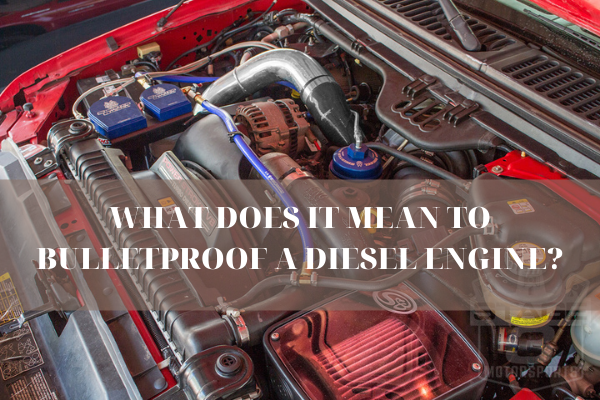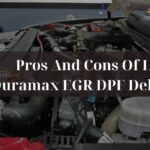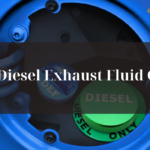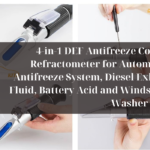What Does It Mean to Bulletproof A Diesel Engine?
The term “bulletproof” in the diesel industry usually means just one thing, but it comes with three caveats. The phrase bulletproofing a diesel engine means that it can withstand extreme amounts of abuse without making any major repairs. The caveat is that this only applies to certain diesel and their special features within the fuel system. It has nothing to do with the actual strength of the block itself, but rather how well it is protected from outside damage.
The second caveat is that there are many people out there who would consider themselves “diesel experts” or have done lots of research on diesel or both, so not everyone will define bulletproofing in exactly the same way.
The general agrees that bulletproofing a diesel engine means that the fuel system is protected from outside contaminants, but beyond that, it can have multiple meanings. It will usually include things such as using high-quality components, specific brands, and higher-than-stock viscosity lubricants to further protect the fuel system.
Finally, there are three major areas that the “bulletproof” term applies to cold weather starting (cold crank), extreme air intake temperatures like those found in offroad racing or desert conditions where the engines run extremely rich mixtures or with poor turbocharger oil return; and preventative maintenance items like replacing worn pushrods early enough to avert catastrophic damage due to their increased wear rate.
The first bulletproofing methods were used in conjunction with the advancements made to turbochargers, which were first introduced back in the early 1970s.
The fuel systems were not built strong enough to handle these new turbocharged engines. To solve this problem, special high-pressure (over 4250 psi) pumps and hoses had to be installed. These are still being used today, but there have been advances in parts that are just as effective at preventing broken engine components without having any notable drawbacks.
Even now the term “bulletproofing” is still synonymous with diesel performance though it is now more of a marketing ploy than anything else. While there are many people whose definition of bulletproofing means different things, they would agree on two things. It means to use high-performance parts and lubricants, and it was originally meant to help protect the fuel system from damage due to extreme engine conditions.
Because of the many people who have a different take on what “bulletproofing” a diesel engine entails, this may mean using certain brands or types of components as opposed to others. As a result, there are some out there who would consider themselves experts but still might not agree on exactly what “bulletproofing” means in their particular case because they don’t follow those other aspects that others do.
In any case, though, the version of bulletproofing that everyone agrees with is about protecting the fuel system from outside contaminants, which is mostly achieved through using high-quality components and advanced lubricants such as those specifically marketed for diesel.
The original intent of the term bulletproofing had to do with protecting the fuel system from damage due to extreme engine conditions by using high-pressure pumps and hoses, but this has evolved over time. While some still use it in reference to their specific case and how they go about performing maintenance on the diesel engines, the general consensus is that it refers to using high-performance parts and lubricants which will help prevent major problems from occurring later down the road when you least expect it.
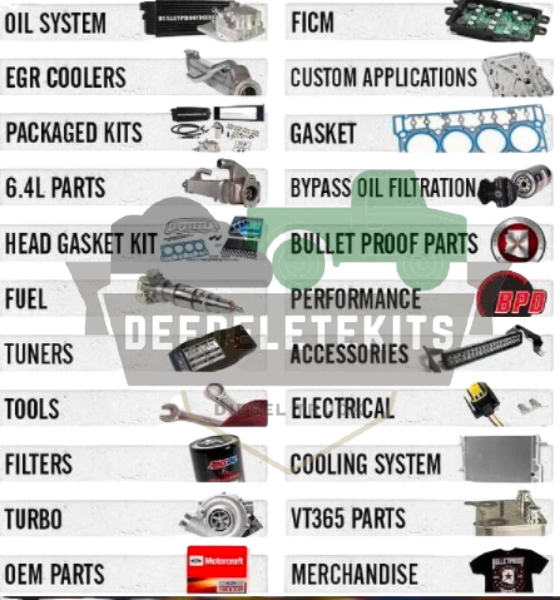
The proven way to bullet proof
So I’ve been getting lots of emails asking about the best way to bulletproof a Powerstroke. Many people are concerned about the 07-09 block cracking issue.
Here is what you need to do, in order, to make your truck bulletproof.
NOTE: The first thing you should do is install new head bolts with ARP’s L19 head studs after carefully torquing each bolt using molly coated spanners for this process. Also, change the oil pan gasket and re-torque that as well. This should prevent any potential low oil pressure issues which can cause bearing failure without proper lubrication.
1) Stage 2+ Performance Tune – This tune takes advantage of your larger injectors, larger FICM voltage range, and the improved torque curve of the 6.0 Powerstroke bulletproof kit to bring your truck up to approx. 325 hp/440 ft lbs of torque depending on your mods. This is enough hp to get you out of most potential trouble during normal driving especially with a bulletproofed engine, but if you’re really concerned about maxing out your power at any rpm I would recommend getting a dyno tune or adding an exhaust brake for more control in low rpm situations.
2) BPD vgt – My favorite mod is the BPD vgt delete kit because it saves 15 lbs overall when compared to AFE’s weight reduction intake manifold plus gives you better throttle response when accelerating off the line due to the fact that you can now control your air/fuel curve without opening and closing the vgt doors.
3) EGR Delete – This mod is a must, but I highly recommend installing coolant filtration as well (see tip #4). If you don’t want to pay for a coolant filter kit then simply find yourself an oil catch can and dump it every other day, because removing this “unnecessary” part of your engine prevents lots of carbon build-up which may eventually lead to low oil pressure issues.
4) Coolant Filter with Bypass – The stock Powerstroke cooling system is actually very similar to older Cummins engines except the CTS-V’s have aluminum heads instead of cast iron. This means that when you remove the EGR cooler and its recirculation valve, you’re actually right below your engine block which makes it easy to add a coolant filter with bypass to keep any harmful particles out of your oil cooler and better circulate the fluid throughout your entire cooling system.
5) Aftermarket Oil Cooler – If you’re going to stick with OEM parts I recommend upgrading from the stock oil cooler to a larger one such as a valley fill or arp sandwich adapter for more efficient heat transfer away from your engine into the ambient air. Over time this will help prevent hot spots in certain areas of your truck, especially when switching from hard acceleration back down to cruising speed after passing someone on the highway.
6) Aftermarket Programmable FICM – This is a must-have for high-powered tunes, to stay on the safe side I recommend getting the ARP head studs installed with this mod as well. The next best thing would be an upgraded fuel pump which you can find here.
7) Bulletproofed injectors – Now that you’ve maxed out your stock injectors it’s time to get some larger ones. For about $1000 you could upgrade all 8 of your stock injectors to a set of 4 CMD billet aluminum black edition ones that flow up to 540cc/min each or you could go big and get yourself some brand new custom fabricated HPOP nozzles with your choice of flow rates and spray angles.
If you’re an advanced 6.0 owner then I’m sure you already know that the HPOP nozzles are what controls everything on your truck, so if you want to maintain the highest amount of control over your injectors while adding more fuel during high hp/tq situations it’s time for some aftermarket nozzles!
8) Aftermarket oil restrictor kit – The next mod in line would be to get rid of anything that restricts the flow of oil throughout your engine especially when pushing her past 3500rpm. GM did a very poor job with their stock oil restrictor channels located here, but thankfully BulletProofDiesel got us covered with an awesome oil restrictor kit that works with a 2.5″ hose and all the fittings you’ll need to plumb everything together.
9) Bulletproofed turbo – Now for this next mod it’s actually recommended that you have your engine completely taken apart down to the bare block so it’s the perfect time to install some dampening sleeves, upgrade your injectors/pump, replace all your gaskets, and if you really want the most out of your 6.0 I’d also suggest going ahead and having a custom oil pan made but that’s only going to be necessary if you’re maxing out at over 650hp+.
If I was just starting my build I would first invest in a quality tuner who can help get the most out of your 6.0, but if you’re feeling confident in yourself then feel free to give BulletProof Diesel a shot at tuning your truck for you! After that have them put together the “perfect” setup by building your custom turbo, manifolds/downpipes, and an oil drain system with either a billet or modified stock pan. Trust me when I tell you that aftermarket manifolds are probably one of the worst investments to ever grace our trucks so save yourself some time and money here.
10) Custom long block – Well congratulations on making it this far if you haven’t already sold everything off your Powerstroke by now. This is where things get crazy expensive but should also yield some pretty awesome results. Now if you want to get the most out of your 6.0 I recommend having a local machine shop make you a custom block with an enlarged displacement such as 298 or even 331 cubes (5.3).
Of course, this will take some very careful planning and require re-boring/honing, sleeving, and ARP head studs but it shouldn’t be too hard to pull off for around $7000 or more depending on who does the work for you and how much they charge.
11) Custom turbo setup – This is where things start getting really expensive, so trust me when I say that there is no better time than now to max out your credit card! If you haven’t already maxed out your stock turbo with a “custom” manifold/downpipe combo then it’s time to upgrade that as well as all of the other supporting mods you’ve already installed.
The best option for those of us looking to actually win races would be to purchase a turbo from Garrett, Holset, or Precision and have them custom-build you an exhaust housing with a .75 A/R ratio. On top of that if you’re going crazy I’d also recommend having a custom underpin made so you can keep your truck looking 100% factory which should also help improve aerodynamics.
12) Custom – Well congrats on making it this far! If none of your current mods have been upgraded then this is the perfect time to do so. The next items you’ll want to invest in are a quality tuner and AEM FIC piggyback (control unit). If you’re like most of us and still looking for that extra few ponies then it’s also time to invest in either an aftermarket downpipe or custom exhaust system with either a DPF delete or turbo muffler!
13) Custom intake scoop – Now if none of these mods have been done yet I recommend picking up a Black Widow or one of the other major SCS manufacturers’ intakes, not only will they greatly improve throttle response but they’ll also add anywhere from 30-50 horsepower. But what if you’ve already maxed out everything else? Well if you’re still serious about breaking into the 7-second zone then it’s time to take your ride straight to a body shop for some fiberglass work. I don’t care what anyone says but once you’ve made this upgrade you might as well have your truck straight-piped because there isn’t much point in trying to be stealthy anymore!
14) Custom turbo-back exhaust – Congratulations if you’ve finished all of the previous modifications, but trust me when I tell you that the best has yet to come! The next mod which will yield great results is installing either an H&S or SCT tuner with Big Wig upgrades.
Now depending on what dyno numbers you’re looking for It’s also time to make sure that your exhaust system is exactly what it needs to be. This should include a full 3″ turbo-back system, a DPF delete with resonator, and an AEM FIC piggyback which should yield some pretty awesome results!
15) Custom intake – The last modification you should look at doing is installing a cold air intake such as the Takeda or AFE. This will provide your 6.0 with cooler oxygen denser air for more power and better throttle response; however, if this isn’t enough there’s still one more option! An aftermarket intercooler such as the Banks i23 will not only give you great cooling capabilities but can also greatly improve horsepower/torque figures by allowing your turbo to work less to reach its maximum potential.
So there you have it, folks! It isn’t easy but with some careful planning and a little research, you can easily transform your Ford into a blisteringly quick diesel capable of reaching the 7-second mark! However, don’t forget that even though doing all of these mods will yield great results there are several other options available that are no less important such as power adders, proper tuning, etc.
Ford 6.0 Bulletproof Upgrades
This article is for those who own or plan to own a 1999-2003 Ford Powerstroke. This isn’t an all-encompassing article of every upgrade that can be done to the 6.0, just some upgrades that have been proven themselves through time and hard miles on many different vehicles.
This list will not include intake manifolds because there are too many options out there to say what you should go with. If I listed them they would probably be outdated by the time this is published so do your research and choose one that best suits your needs.
There are 2 ways you can do EGR delete:
1)You can drill a .25″ hole in the side of the exhaust manifold and install a plug (as per Bulletproof Diesel).
2)You can purchase a DP-51 kit from Bulletproof Diesel. The kit comes with a blanking piece that is installed in the EGR tube and a plug for the exhaust manifold to seal it off. This option will protect you from having to drill an extra hole in your exhaust manifold but will cost more than just drilling a small hole in there yourself.
If you plan to add modifications such as tuners, intakes, injectors, etc… you will need to get a catted H pipe at a minimum because the factory Catback does not flow well enough for all of that added backpressure if everything else is stock. With tune + intake + full exhaust there’s about 12psi of backpressure from these items.
You’ll need new fuel lines eventually, but the factory ones are fine for about 10psi of boost. After that, they can start leaking so it’s best to upgrade them sooner than later.
If you have a leaky valve cover gasket, this is one of the cheapest and easiest upgrades you can do right now. Some people will argue that if your truck isn’t modded then there’s no reason to change it out, those people don’t know how fast an open EGR cooler will drain down your batteries and leave you stranded on the side of the road because your truck won’t start! I’ve seen it happen with my own eyes….twice actually (not including myself). If you want to save yourself some time and money, change your valve cover gasket.
If you’re still stock injectors then I would recommend getting the chip tuned now if you haven’t done so already. On most tunes, they allow for higher fuel pressure which will help with your turbo-diesel engine. If you decide to buy used aftermarket injectors make sure that they are “cetane matched” or else they may not work properly in your truck. These tend to be more expensive but well worth it in my opinion so whatever route you choose is up to you! There’s nothing worse than spending $1500 on new injectors only to find out they don’t work right because the company didn’t cetane match them for your application.
There are two schools of thought on this, you can either delete the EBPV and go with a 3″ straight pipe or convert it to a full 4″ exhaust system. Both have their pros and cons but if you ask me, I say delete it while your stock manifolds are still in place because while some people have had great luck keeping the stock manifolds, I had horrible luck with mine cracking on my driver’s side within about 2 weeks of having my truck back from ford after the recall.
If you’re going to add injectors then you might as well get yourself some new fuel lines too while you’re at it since your old ones are probably starting to show their age now. The stock supply line is 20i max working pressure so no need to go with anything more than that if you’re still stuck.
Driving around town and short trips are fine but if you plan on doing any towing then it’s best to upgrade your transmission cooler while you’re at it or else you might end up stranded on the side of the road again.
On some tracks, the FICM is mounted in a really awkward spot, plus it has no cover so every time I drove through a puddle I would get water all over it which was pretty annoying. Now that mine is mounted under my airbox behind my MAF sensor there isn’t much chance of water getting on it anymore! Plus now instead of having 4 wires going into one bolt, everything is nice and organized with 8 bolts holding it in place.
The factory fuel filter screen is very restrictive, not only will it restrict your fuel system by about 5-8 psi but you’ll also find that dirt and other particles will easily pass through it and clog up the screen which requires a pretty pricey replacement part from ford.
A shame too since they make them out of plastic! Do yourself a favor and buy a metal aftermarket one instead, I’ve been running one of these on my truck for almost 2 years now without any problems or restrictions whatsoever! If you’re going to be adding injectors then do yourself a favor and get this as well because if anything gets stuck in your new injectors there’s no way you’re going to be able to clear the filter on them yourself.
You can get away with keeping your factory rear diff for a while, but eventually, you’ll want to upgrade to some type of aftermarket cooler if you plan on doing any off-roading. This is the cheapest way to do it too since they usually run about $100-150 compared to the more expensive options out there.
If you’re going the route of aftermarket injectors then swapping your fuel filter is just as important because these are hand-built by Roush instead of being mass-produced by ford so they have tighter tolerances which can sometimes cause leaks. A new filter will provide a better seal between the fitting and ensure that everything stays where it belongs!
Stock DSM limits boost pressure to around 30 psi (on a good day) but are very weak once you get up around 40 psi even with an upgraded turbo. This is why most people opt for the DIY in-line boost valve upgrade in order to raise their boost levels safely in order to prevent damage to their turbo or engine in general.
There are three different options when it comes to exhaust upgrades, go with the cheapest one which is just deleting your factory donut gasket and replacing it with some high-quality cut/weld 3″ tips or go all out and spend $1500+ on the back! Your choice but I know that I went ahead and did both so mine has awesome sound quality with awesome power delivery at the same time, plus everyone always comments on how awesome they sound so it’s a win-win for me!
Granted I’ve only been running mine for about 3 months and didn’t do the DSM delete when I originally did my exhaust but still, you get the idea that it helps quite a bit with airflow. Plus another plus side to doing this is if you’re going the catless route then this will help keep everything under control since it won’t be releasing any exhaust particles into your turbocharger.
Every DSM sucks in hot air from underneath their car, whenever you stop at a light or whatever your engine bay is going to heat soak which also heats up your oil causing premature wear over time. If you want to add some extra power gains as well as prevent heat soak then take a trip down to your local pick-n-pull and snatch yourself an OEM engine cover, they’re usually in pretty bad shape with lots of flooring scratches on them but who cares when it’ll be covering up all that ugly junk underneath the hood!
Originally I didn’t want to do this because I was afraid that it would affect my MPG or cause any problems with shifting but I already had the part laying around so what the heck. The air conditioning delete is very easy to do since you don’t even need any tools (except a drill) and will only take about 5 minutes to complete. All you have to do is remove the air conditioning accumulator box which releases all the pressure inside of it, then find one of the white wires running into the box and simply cut it.
If you don’t feel like splicing anything on your own then there are also companies out there than can do this for you, or if you want to be 100% safe with no chance of leaking then take your car over to A1 Autosports in Tustin since they’re the ones that taught me how to complete this mod properly. On a side note, I did get an A/C delete code after doing this but resetting my ECU fixed the problem within minutes so no harm done!
Again not required by any means but if you plan on pushing your vehicle past factory limitations (which I’m sure most of us will) then it’s highly advised you upgrade your clutch as well! Even with the DSM delete, upgraded turbo, and exhaust I still managed to destroy my stock clutch within 50 miles of driving. Changing your clutch is another DIY project that you can complete by yourself if you’re the kind of person who likes to tinker with their car but I personally took mine down to Vastooki since they were able to do it in under an hour without any problems!
This article was inspired by so many others out there who only talk about power gains rather than maintenance or precautions needed when modifying your vehicle. Sure adding more horsepower is incredibly fun but taking precautions so things don’t go wrong will not only save you money but also time, which is just as valuable if not even more so! If you enjoyed this article then please feel free to share it with your friends and other DSM owners out there.
That was quite a long article but I hope that everyone learned something new from reading this! If you have any questions or would like to contact me about the products I wrote about in this article then please email me at defdeletekits@gmail.com.
What Does It Mean to Bulletproof A Diesel Engine?
A bulletproof diesel engine is nothing more than a tuned-up diesel engine. I will get into the details of what that means below, but to get right to it…
You can not get a stock or even lightly modded diesel car to go faster without changing the following parts:
-the turbocharger (better boost, more power)
-the injection system (more fuel in = more power)
-The Head (block) – head studs for better cylinder compression, and higher performance gaskets for less cylinder leakage ”’*added note*”’ If you are willing to risk running low octane gas (87/89 octane) you can make the stock head work better, but it will require some trial and error. If you want to keep your 87/89 octane gas, you need a head gasket upgrade.
Tuning – this can be done either through Actron or Unichip offroad programmers with a custom tune (big differences in power)
-Exhaust downpipe (more airflow = more power)
Diesel is most efficient at part throttle, where they can supply all of their own air with no assistance from the turbocharger boost. Stock diesel also has very large backpressures at part throttle which inhibits airflow for that reason well as others. The bigger the downpipe, the less backpressure there is. Bigger downpipes will also make your car smoke more until you get everything re-adjusted to compensate for the lower backpressure (EGT sensors, various other sensors).
It should be noted that parts like injectors and turbochargers do not increase power; rather they allow you to safely utilize that power without damaging anything in the process. This cannot be said about exhaust upgrades…
One other thing people like to install on their cars are chips… these are what give your car all of its power gains by changing how it runs; this can range from simple adjustments like recurving the boost to giving it a far greater amount of overall power. Chips are wonderful things but beware! Many chips can not handle the increased power of bigger turbos or more complete builds.
For example, some chips are only rated for 300hp but you have a 400hp engine with a turbo that spools faster than an F1 racer… these chips will give you all kinds of false readings and will cause problems if they try to read the engine correctly. This is why most serious tuners go custom…
These upgrades are done in stages – do one stage at a time, make sure it works before you move onto the next stage. Do not expect big gains without investing some money into your car since most parts are expensive – even cheap ones…
There are also several other parts which I am about to discuss which you can do with your car – some of these parts will be cheap, but it is suggested that you save up a bit before tackling these as they may require more work or money to complete…
One of the first things people like to upgrade on their cars is the turbocharger – this allows for more power without any other changes. Simply put, if you want more power from your car, you need a bigger turbocharger and intercooler, etc…
There are many companies that offer better turbos than stock and usually offer them in stages:
Stage 1 – This is simply a replacement turbocharger that offers no additional features over stock (except more power) – These usually bolt right up to your existing setup and offer more power, but they will also boost up to higher boost pressures than stock so be careful – they can destroy your engine just as easily as they can make it go faster. If you are serious about modifying your car I would suggest getting one of these.
Stage 2 – These turbos come with their own oiling systems and usually bolt right up to most cars with very little modification. The biggest issue with stage 2’s is that there is no real upgrade path for them – if you want bigger upgrades you need a new turbo…
-Intercooler (more airflow through intercooler = more power)
Now some people will say that the first thing they do when modding their car is getting an intercooler… this is a fairly expensive upgrade for first-time modders as it requires a lot of work to install properly and some special tools which you may not have. It also makes more noise than the turbocharger itself! Unfortunately, the amount of power increased from an intercooler will be far less than that of getting a bigger turbo – if you are looking for straight-up power gains, get the turbo first.
So now let’s assume that you just got your stage 2 or 3 turbos installed with good custom tuning (many tuners offer great tunes at reasonable prices)… well, what do you do next?
Well, if your car is very powerful already then the best thing to do would be to get everything else in your engine checked out;
O2 sensors (pre and post-turbo) – These control the amount of air that is let into your engine through a series of readings, you can add or remove fuel to get the desired effect. If these are broken then it will throw off all of your tunes and start destroying things – be sure to replace them when you install new parts on your car.
Oil pump – These are fairly cheap upgrades but they have been known to cause serious problems if they aren’t matched correctly with upgraded internals… so only get one after you have done some good research into what works well with what.
-Clutch – this will increase the power which you put towards moving – by getting a new clutch and having it installed properly you will be able to increase the power of your engine by around 15-20% – It is fairly cheap and easy to install if you know what you are doing.
All of these parts should be done in stages – don’t go out and get just one, get them all at once after you have tested each individual mod… unless your car breaks down early!
So, chances are that you already have a nice tune on your car… well now it’s time for bigger injectors (which can make a huge difference) big intercooler, bigger turbocharger! Now does this mean that everyone should go stage 4? Well, I would say no because not everyone has the money to spend on stage 4 or high-powered turbochargers… but when you get there, come back and read this article again!
Conclusion
Bulletproofing a diesel engine is the process of strengthening and protecting an existing diesel engine from wear. This can be done by adding metal to make it more durable or through other means, such as using special coatings that prevent rust. The main reason for this type of maintenance is to extend the life span of your vehicle’s expensive investment in a new diesel engine. Bulletproofing your Diesel Engine should only be performed by professionals because there are many risks involved with working on engines. It’s important not to underestimate these risks so you don’t cause any permanent damage while trying to save money!
